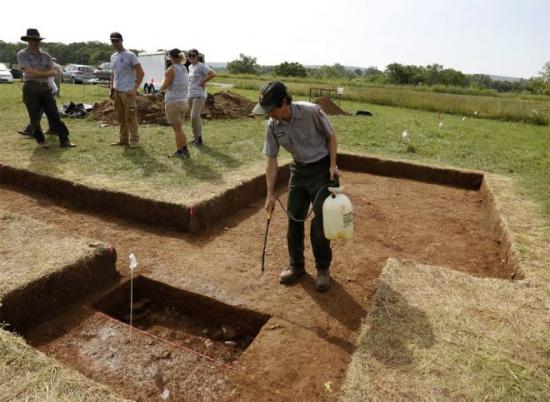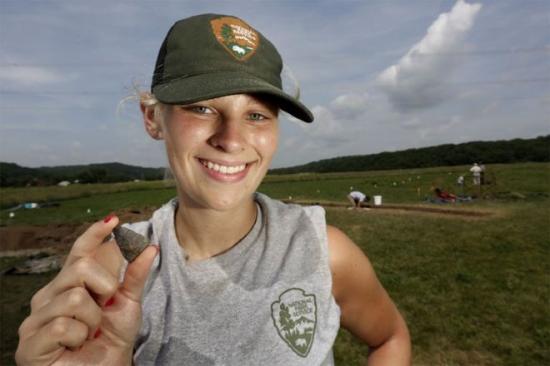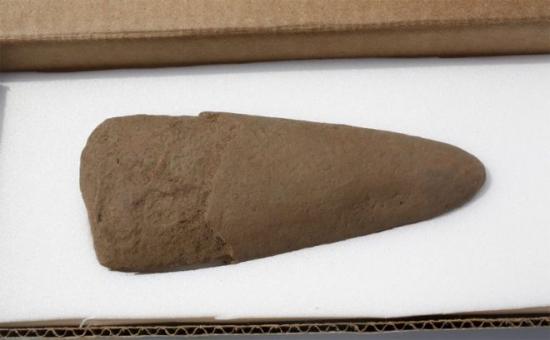Mary Beth Lane
Source - http://www.dispatch.com/content/stories/local/2014/06/23/hopewell-excavation-seeks-evidence-of-a-woodhenge.html?

National Park Service employee, Patrick Zingerella, wets the earth with water to expose color variations in dirt at the Hopewell Mound Group in Chillicothe, Ohio.TOM DODGE | DISPATCH
The ancient people of the Hopewell culture who built earthwork mounds in Ohio 1,600 to 2,000 years ago continue to give up their secrets.
The latest might be a “woodhenge,” a circular enclosure of wooden posts. Imagine Stonehenge, but with timber.
National Park Service archaeologists who are excavating a field at Hopewell Culture National Historical Park near Chillicothe believe they have found evidence of such a wooden-post circle.

Cailey Mullins from Portsmouth, holding a "tip of a point" that was found at the Hopewell Mound Group in Chillicothe, Ohio. TOM DODGE | DISPATCH
It would have been built by the same civilization that constructed the earthwork mounds near Chillicothe, in Heath and Newark, and near Lebanon in southwestern Ohio.
More testing and analysis remain to be done before they can be certain. But the archaeologists believe that the stains of darker soil they are discovering in intervals several feet beneath a field are evidence of wood — long since rotted into the earth — that once made up the circular enclosure.
“I am very confident,” said park archaeologist Bret Ruby, who is leading the team excavating an area known as the Great Circle, “that those represent wooden posts.”
The excavation is taking place as Ohio leaders await word on whether the multilocation Hopewell Ceremonial Earthworks will win designation as a World Heritage site.
Recognition by the United Nations Educational, Scientific and Cultural Organization would boost the profile of the Ohio earthworks, help to preserve and protect them and increase tourism, proponents say.

A celt, found at the Hopewell Mound Group, was probably used by the ancient people to cut wood or dig. TOM DODGE | DISPATCHA
By some estimates, the current number of 35,000 visitors annually to the Hopewell Culture National Historical Park could increase to 10 times that if the Ohio earthwork collection is listed as a World Heritage site, said park Superintendent Dean Alexander.
Leading advocates for the designation include two former Ohio governors and their wives — Bob and Hope Taft and Ted and Frances Strickland — and professionals from the Ohio History Connection and the National Park Service. The group is to hold a community briefing in Chillicothe on July 1 to discuss the site nomination.
It is a lengthy undertaking, and a decision is not expected soon.
Meanwhile, Ruby leads a team that has been working since May 19 to excavate the Great Circle at the Hopewell Mound Group west of Chillicothe.
The Hopewell Mound Group is among five earthwork parks that make up the Hopewell Culture National Historical Park.
The Great Circle, which measures 375 feet in diameter, was identified as an area of archaeological interest by magnetic testing conducted several years ago. The testing showed “ anomalies,” or soil disturbances, that Ruby suspects are the remains of wooden posts. The dig is the next step in determining whether they are.
“Nobody has ever sought to figure out what this Great Circle was used for, when it was built. We knew it was here, but no one had done any excavation,” Ruby said.
“We are trying to tell a broader story about the Hopewell, what they might have been engaged in here and their daily life.”
Woodhenges are not common but not unheard of in Ohio.
Excavation in recent years at the Fort Ancient earthwork near Lebanon in Warren County has revealed posthole marks laid in concentric circles. Archaeologists working on that site believe the wooden-post circles were the focus of ceremonial life for the Hopewell culture.
The dig near Chillicothe is likely to take a few more weeks. The Great Circle excavation already has yielded one prize. Archaeologists unearthed a ground-stone tool, 6 inches long and 2 1/2 inches at its widest, with an axlike end. It was probably used by the ancient people to cut wood or dig, Ruby said.
“This is once-in-a-lifetime — this is rare,” he said, beaming like a proud parent as he showed off the tool that the team found on June 11.
Dispatch Reporter Eric Lyttle contributed to this story.